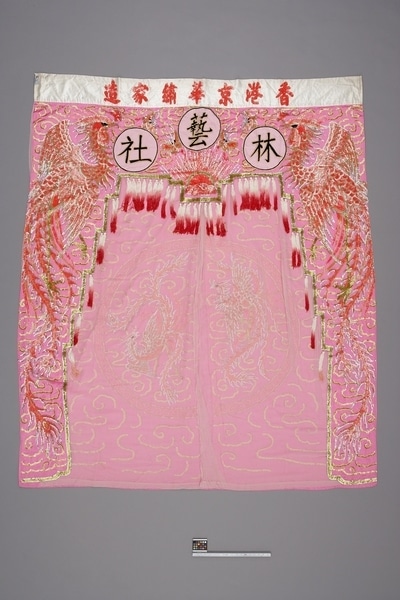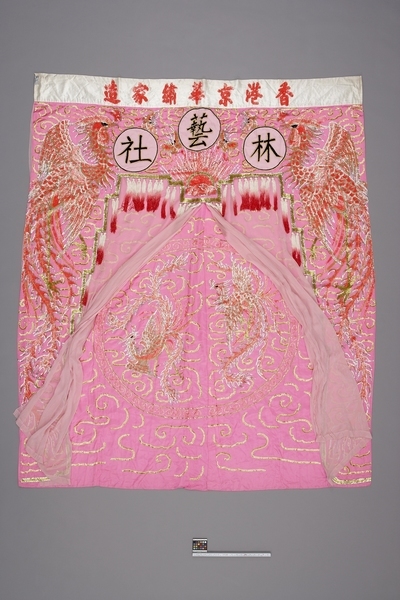Cantonese Opera Bed Curtain Item Number: 2701/14 from the MOA: University of British Columbia


Description
Curtain of pink synthetic fabric sewn to form an arch-shape with horizontal upper edge of white synthetic fabric to which seven orange-pink Chinese characters are applied with sequins. There is a layer of filmy pink synthetic fabric over this. At the centre of the curtain set are appliquéd three discs of pink silk, each with a Chinese character in black cloth. The lower edge of the arch-shaped curtain has a row of dark pink fringe. Behind the arch is a rectangular panel, and there are curved vertical panels with cotton backing attached to the sides. All are decorated with phoenixes, executed in dark pink, gold, and silver sequins.
History Of Use
Beds appear frequently in Cantonese opera, represented by a narrow platform with a cover and bed-curtains, as well as sometimes with cushions or bolsters. They most often are used in scenes representing weddings, although the actors do no more than sit on the bed and are not shown lying down. During the years 1900-1930, Cantonese opera costumes and stage fittings were decorated with silver-plated brass discs and then with round mirrors, together with gold and silver thread. Sequins made of gelatin were first used on Cantonese opera costumes in the 1930s. Heavily-sequined costumes were popular in the 1950s-60s, with the sequins then being made of plastic. Sequins have continued to come and go in popularity since that time. Silk bed sets in general predated those made of synthetic fabrics.
Cultural Context
Cantonese Opera Performance
Item History
- Made in Hong Kong, China during 1965
- Collected in Vancouver, British Columbia, Canada
- Owned by Ngai Lum Musical Society before April 21, 2008
- Received from Ngai Lum Musical Society (Donor) on April 21, 2008
What
- Name
- Cantonese Opera Bed Curtain
- Identification Number
- 2701/14
- Type of Item
- curtain
- Material
- synthetic fibre, plastic, dye and cotton fibre
- Manufacturing Technique
- sewn and painted
- Overall
- height 233.0 cm, width 183.0 cm, depth 2.0 cm
Who
- Culture
- Chinese: Cantonese
- Previous Owner
- Ngai Lum Musical Society
- Received from
- Ngai Lum Musical Society (Donor)
Where
- Holding Institution
- MOA: University of British Columbia
- Made in
- Hong Kong, China
- Collected in
- Vancouver, British Columbia, Canada
When
- Creation Date
- during 1965
- Ownership Date
- before April 21, 2008
- Acquisition Date
- on April 21, 2008
Other
- Item Classes
- textiles
- Condition
- good
- Accession Number
- 2701/0014